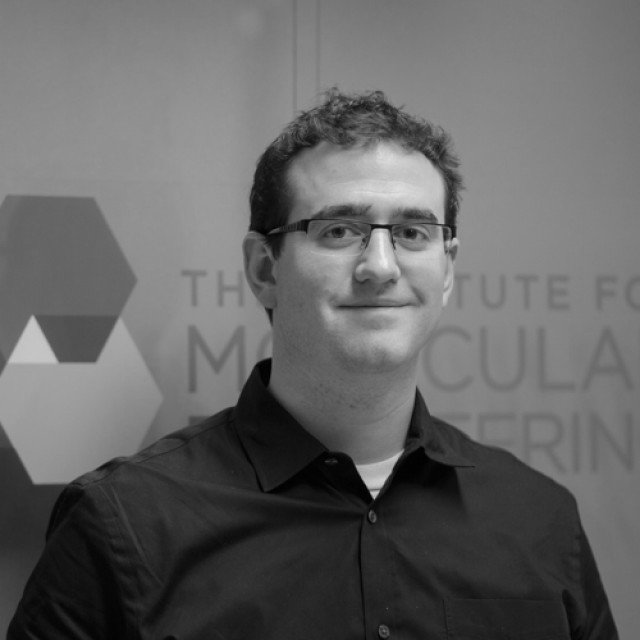Chris obtained his Bachelor of Science in chemical engineering from the University of Illinois at Urbana, Champaign (UIUC), in 2005. At UIUC, he performed undergraduate research under Professor Christopher Bardeen (now at University of California, Riverside) studying electron energy transfer mechanisms in macromolecular systems, such as organic dendrimers and DNA, using ultrafast laser spectroscopy.
After completing his bachelor’s degree, Chris worked four years in pharmaceutical research and development at Hospira and Baxter International. At Hospira, he contributed to the process development of lipid-emulsion drug delivery vehicles; at Baxter, he developed continuum-based mathematical models to assess the transport phenomenon at drug solution-medical plastic interfaces. While working full time, Chris earned his Master of Science in chemical engineering at North Carolina State University in Raleigh.
In 2009, Chris went back to school to earn his PhD in chemical engineering. He attended the Illinois Institute of Technology (IIT) in Chicago, working with Professor Vijay Ramani. During his tenure at IIT, Chris made significant contributions to understanding and mitigating polymer electrolyte membrane (PEM) degradation in electrochemical energy conversion and storage devices that span fuel cells (both acidic and alkaline), water electrolyzers, and the all-vanadium redox flow battery. Chris was the first to apply multi-dimensional NMR methods to understand the alkaline degradation of anion exchange polymer electrolyte membranes. Additionally, he helped pioneer the use of an in-situ micro fluorescence probe to acquire real-time monitoring of reactive oxygen species generation (bad actors responsible for PEM degradation) within an operating fuel cell. Chris was the recipient of the Student Achievement Award from the Electrochemical Society in 2013 and he earned the Best Student Award from the Gordon Research Conference on Fuel Cells in 2012. He has been selected as a discussion leader at the Gordon Research Seminar on Fuel Cells in 2014. A list of his publications can be found on Google Scholar.
Chris’s research interests lie at the intersection of polymer science and electrochemical systems. At the University of Chicago, his research employs directed self-assembly (DSA) tools for organizing ion-containing block copolymer electrolytes into desired morphologies that optimize their ionic conductivity and species selectivity. Improved ion transport for polymer electrolytes is paramount for the next generation of more efficient electrochemical energy conversion and storage (e.g., fuel cells, water electrolyzers, redox flow and metal ion batteries, and electrodialysis). Under the guidance of Professor Nealey, Chris is looking at surface patterning techniques using nanolithography, as well as supramolecular chemistries, for creating hierarchical assemblies of ionic domains for facile ion transport while the non-ionic domains provide membrane mechanical integrity and species selectivity.
Role of Defects in Ion Transport in Block Copolymer Electrolytes
Kambe, Yu, et al. "Role of Defects in Ion Transport in Block Copolymer Electrolytes." Nano Letters (2019).
Directed self-assembly of colloidal particles onto nematic liquid crystalline defects engineered by chemically patterned surfaces
Li, Xiao, et al. "Directed self-assembly of colloidal particles onto nematic liquid crystalline defects engineered by chemically patterned surfaces." ACS nano 11.6 (2017): 6492-6501.
Controlling Domain Orientation of Liquid Crystalline Block Copolymer in Thin Films Through Tuning Mesogenic Chemical Structures
Xie, H. L. Li, X. Ren, J. X. Bishop, C. Arges, C. G. Nealey, P. F.. Controlling Domain Orientation of Liquid Crystalline Block Copolymer in Thin Films Through Tuning Me. Journal of Polymer Science Part B-Polymer Physics. 2017. Vol. 55, Pg. 532-541.
Directed Self-Assembly of Polystyrene-b-poly(propylene carbonate) on Chemical Patterns via Thermal Annealing for Next Generation Lithography
Yang, G. W. Wu, G. P. Chen, X. X. Xiong, S. S. Arges, C. G. Ji, S. X. Nealey, P. F. Lu, X. B. Darensbourg, D. J. Xu, Z. K.. Directed Self-Assembly of Polystyrene-b-poly(propylene carbonate) on Chemical Patterns via Thermal A. Nano Letters. 2017. Vol. 17, Pg. 1233-1239.
Interconnected ionic domains enhance conductivity in microphase separated block copolymer electrolyt
Post-directed-self-assembly membrane fabrication for in situ analysis of block copolymer structures
J Ren, L E Ocola, R Divan, D A Czaplewski, T Segal-Peretz, S Xiong, R J Kline, C G Arges and P F Nealey. Post-directed-self-assembly membrane fabrication for in situ analysis of block copolymer structures. Nanotechnology. 2016. Vol. 27, Pg. 435303.
Perpendicularly Aligned, Anion Conducting Nanochannels in Block Copolymer Electrolyte Films
Arges, CG; Kambe, Y; Suh, HS; Ocola, LE; Nealey, PF. Perpendicularly Aligned, Anion Conducting Nanochannels in Block Copolymer Electrolyte Films. Chemistry of Materials. 2016. Vol. 28, Pg. 1377-1389.
Directed Self-Assembly of Hierarchical Supramolecular Block Copolymer Thin Films on Chemical Pattern
Guang-Peng Wu, Xiaoying Liu, Xuanxuan Chen, Hyo Seon Suh, Xiao Li, Jiaxing Ren, Christopher G. Arges, Faxue Li, Zhang Jiang and Paul F. Nealey. Directed Self-Assembly of Hierarchical Supramolecular Block Copolymer Thin Films on Chemical Pattern. Advanced Materials Interfaces. 2016.
